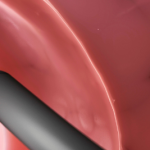Hiatus Hernia
When the gastro-oesophageal junction moves up through the diaphragm, taking with it some of the stomach, a hiatus hernia is present.
What is hiatus hernia?
Normally, the junction between the food pipe (oesophagus) and the stomach is at the level of the diaphragm. When this junction (the gastro-oesophageal junction) moves up through the diaphragm taking with it some of the stomach, a hiatus hernia is present.
What causes a hiatus hernia?
With age, the elasticity of the diaphragm and supporting structures is reduced and thus the gastro-oesophageal junction and stomach can move up (“herniated”) into the chest cavity. Hiatus hernias occur in about 20% of the population and frequently cause no symptoms.

What are the symptoms of a hiatus hernia?
Hiatus hernias are frequently associated with “reflux” where the stomach contents move up into the oesophagus. This gives symptoms of heartburn and indigestion.
What are the complications of a hiatus hernia?
Complications include:
- Iron deficiency anaemia
- Ulceration and bleeding
- Fibrous narrowing of the oesophagus




